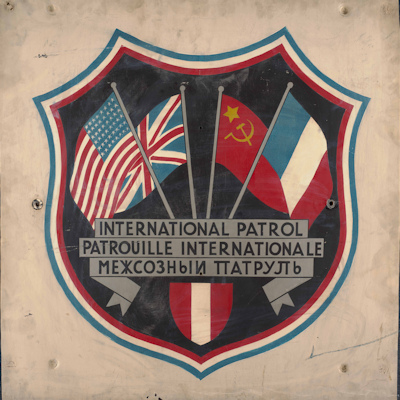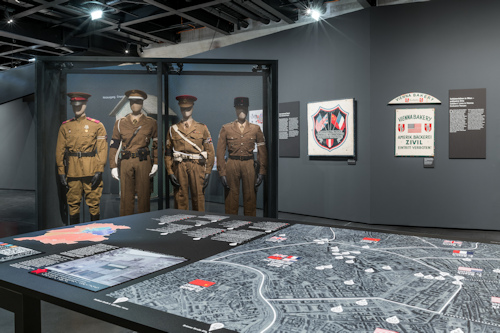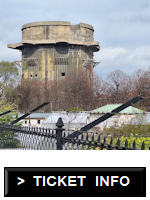The Wien Museum explores life in Vienna immediately after WWII and how cultural influences introduced by the Allies helped Austria (re)build its identity.
- An absolutely fascinating dip into the post-war aftermath
- Documents an era of transition and a process of transformation
- Around 560 objects on display
- Quite moving at times
- Runs Apr 10 – Sept 7, 2025
- Book a guided walking tour* of WWII Vienna
- See also:
The Allied Forces in Vienna

(The USIS – United States Information Service, Christmas parties for Viennese children. Film screening at the “Yank Theater”, 1946 © ÖNB – Austrian National Library, Vienna)
Wander the pristine streets of Vienna’s centre, and you barely find a brick out of place. The old town has grown plump and content on a diet of democracy, wealth, and social cohesiveness.
Look closer, though, and some buildings seem newer than they ought to be. Or a hastily-erected apartment block from the 1950s interrupts a row of historical houses like a filling in an actor’s smile.
Such discoveries reveal that Vienna is partly a phoenix risen from the ashes of WWII.
It feels almost impossible to imagine now, but aerial bombing, ground fighting, and arson left the city pockmarked with craters and rubble in 1945. Watch the movie The Third Man for a flavour of the times.

(“International Patrol” sign, Vienna Police Museum, Federal Ministry of the Interior, III-S-3 Department of Historical Affairs; photo: TimTom, Wien Museum)
The end of the conflict saw Austria returned to a country in its own right, albeit under Allied occupation. The Russians “liberated” Vienna in April 1945, and the remaining Allies arrived in September to take joint control over the city.
Austria and Vienna became a country and city severed from German hegemony and National Socialism. But also a country and city desperately short of food, income and self-respect.
As such, the scars of war went far beyond physical damage.
Reconstruction efforts therefore extended to more than cranes and concrete, as the Controlled Freedom exhibition at the Wien Museum’s main site on Karlsplatz demonstrates. The exhibition appears 80 years after the liberation of Vienna in 1945.
As well as helping to rebuild the economic and political landscape, the Allies also immediately encouraged numerous cultural activities.

(Exhibition view; press photo by Klaus Pichler)
Controlled Freedom takes us through this post-WWII era and the wave of cultural offerings the British, French, Americans and Russians brought to the city to help develop a democratic Austria.
The aim was not to guide Austria and Vienna to one culture or another but to reawaken a national consciousness and sense of independent identity. Albeit, some of that international culture arrived with a significant slice of partisanship, not to say propaganda.
Theatre, cinema, radio, books, concerts, exhibitions, periodicals, cultural exchanges and more all served as inspiration and relief for the domestic population.
Given the deprivations of the late 1940s, a renewed emphasis on culture could seem almost irreverent. “Bread not books” might feel like a better mantra. But as Winston Churchill himself said in 1938:
The arts are essential to any complete national life

(Lothar Rübelt, In front of the Kreuzkino in Vienna’s Wollzeile, 1947; people are queuing to see a cowboy film © ÖNB – Austrian National Library, Vienna)
Although the focus is on culture, Controlled Freedom contains a huge amount of political and historical context. As a result, the overall experience offers insights into a place and time almost inconceivable today (hopefully).
A place where a former Nazi might live next door to a concentration camp survivor and a Russian colonel. A city riven with hunger, uncertainty, and an inconsistent rule of law. A time when women feared sexual violence from the same soldiers that freed them from National Socialism.
The displays begin with projections of the post-WWII cityscape to leave you in no doubt as to the precarious situation of the city.
Then we have objects and paraphernalia that bring life to the era and themes. Interviews with contemporary witnesses, photos & film clips, movie, theatrical, concert & exhibition posters, CARE parcels, ration cards, cigarette packets, nylon tights, flyers…
Not to mention a few details that strike close to your heart. For example:
- A blouse made from parachute silk
- An entrance sign for the Russian zone

(“Russian Zone” sign, 1945-1955, © Vienna Police Museum, Federal Ministry of the Interior, III-S-3 – Department of Historical Affairs, photo: TimTom, Wien Museum)
- The four uniforms of the “4 in a jeep” joint Allied patrols (put together for probably the first time ever)
- A poster advertising a performance of Much Ado About Nothing (the irony)
And a little piece of iconic Austrian history, too: a page from a first draft of the independence treaty that would be signed in 1955.
The paragraph outlining Austria’s shared responsibility for what passed in that nightmarish period of fascism in Europe is crossed out on the page. It never appeared in the final version…but the consequences of that decision are a story for another day.
Dates, tickets & tips
Immerse yourself in the times and culture of post-WWII Vienna from April 10th to September 7th, 2025. The Wien Museum permanent exhibition is free, but the top-floor centerpiece special exhibitions require a ticket: available direct from the museum.
A couple of tips:
- The Wien Museum’s musa gallery also covers the post-war era in its special exhibition, which runs for some of the same time as Controlled Freedom. Truth as Attitude presents the work of the Viennese Realists, who highlighted sociopolitical and sociocultural issues through their art
- The Third Man museum has an extensive historical section on the rebuilding years
- And if you want to explore the physical legacy of WWII, see my location guide or take a short guided walking tour*
How to get there
Karlsplatz has its own subway station (U1, U2 and U4 lines) but for more details, check the tips on my main Wien Museum page. Once inside the museum, go up to the top floor for the exhibition.
Address: Karlsplatz 8, 1040 Wien
